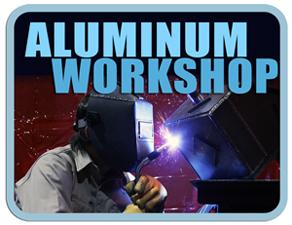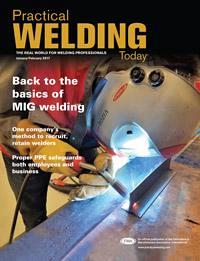President
- FMA
- The Fabricator
- FABTECH
- Canadian Metalworking
Categories
- Additive Manufacturing
- Aluminum Welding
- Arc Welding
- Assembly and Joining
- Automation and Robotics
- Bending and Forming
- Consumables
- Cutting and Weld Prep
- Electric Vehicles
- En Español
- Finishing
- Hydroforming
- Laser Cutting
- Laser Welding
- Machining
- Manufacturing Software
- Materials Handling
- Metals/Materials
- Oxyfuel Cutting
- Plasma Cutting
- Power Tools
- Punching and Other Holemaking
- Roll Forming
- Safety
- Sawing
- Shearing
- Shop Management
- Testing and Measuring
- Tube and Pipe Fabrication
- Tube and Pipe Production
- Waterjet Cutting
Industry Directory
Webcasts
Podcasts
FAB 40
Advertise
Subscribe
Account Login
Search
Aluminum Workshop: Choosing a filler to repair 356.0-T6 casting
- By Frank Armao
- January 30, 2017
- Article
- Aluminum Welding
Q: I have an aluminum cylinder head with a piece broken off and would like to repair it. The casting is made from 356.0-T6 alloy, and I’ve been told by some that I must repair it using 4043 filler metal. Others have said that I need to use a filler alloy that matches the chemistry of the casting. Which is correct?
A: First, 356.0-T6 is arguably the most common aluminum casting alloy used for all sorts of things, including cylinder heads. It is a heat-treatable alloy that contains nominally 6.5 to 7.5 percent silicon, 0.2 to 0.56 percent magnesium, and a maximum of 0.2 percent copper. It is usually supplied in the heat-treated condition in the T6 temper. The good news is that it can be welded easily and reliably with no cracking issues.
So what filler should you use to weld it? The answer for the vast majority of cases is 4043. However, it is an aluminum silicon alloy with no magnesium or copper added, so it is not heat-treatable. You might think this is a problem, but in most cases it isn’t. The fact is the properties of the 356 casting are reduced significantly in the heat-affected zone (HAZ) of the weld, much as in welding 6061-T6, and the strength of the weld metal will be stronger than that of the HAZ. Can the cylinder head be heat-treated after repair to restore the strength of the weld and HAZ? Theoretically, yes, but from a practical standpoint, no. The problem is that the quenching performed as a part of the heat treatment will distort the casting enough so that it is unusable.
A matching filler metal to the 356.0 chemistry is available from a few suppliers; however, the only class of applications for which it must be used are castings that will be completely heat-treated after welding. This usually happens in the foundry, where the casting must be repaired before it is finished. In this case, 356 filler is used so that after heat treating the properties of the repaired area and the HAZ will have the same mechanical properties as the rest of the casting. In fact, it is common practice to cut a scrap casting into long, narrow strips and use them as filler wire for gas tungsten arc welding (GTAW) repairs. After repair, the casting is heat-treated and finished.
That’s the whole story. In your case, I would weld the repair using 4043 and not attempt to heat-treat after welding. The cylinder head should work fine.
About the Author

Frank Armao
Aluminum Consulting Inc.
440-479-0239
About the Publication
Related Companies
subscribe now

The Welder, formerly known as Practical Welding Today, is a showcase of the real people who make the products we use and work with every day. This magazine has served the welding community in North America well for more than 20 years.
start your free subscription- Stay connected from anywhere

Easily access valuable industry resources now with full access to the digital edition of The Fabricator.

Easily access valuable industry resources now with full access to the digital edition of The Welder.

Easily access valuable industry resources now with full access to the digital edition of The Tube and Pipe Journal.
- Podcasting
- Podcast:
- The Fabricator Podcast
- Published:
- 04/16/2024
- Running Time:
- 63:29
In this episode of The Fabricator Podcast, Caleb Chamberlain, co-founder and CEO of OSH Cut, discusses his company’s...
- Trending Articles
Sheffield Forgemasters makes global leap in welding technology

Welding student from Utah to represent the U.S. at WorldSkills 2024

Lincoln Electric announces executive appointments

Engine-driven welding machines include integrated air compressors

ESAB unveils Texas facility renovation

- Industry Events
16th Annual Safety Conference
- April 30 - May 1, 2024
- Elgin,
Pipe and Tube Conference
- May 21 - 22, 2024
- Omaha, NE
World-Class Roll Forming Workshop
- June 5 - 6, 2024
- Louisville, KY
Advanced Laser Application Workshop
- June 25 - 27, 2024
- Novi, MI



























